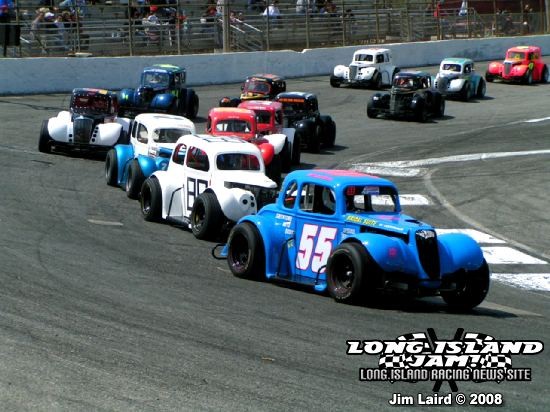 For
seven years, Legends cars had been housed in garages across Long
Island, some shuttered away since the decision had been made to
discontinue the division at Riverhead Raceway, and some brought
out for trips to other tracks. This time last year, however,
excitement began to build for the return of the division. It was
announced in November of 2007 that the Legends would once again
return to the quarter-mile asphalt oval, with a limited
eight-race schedule. New teams were formed in anticipation, some
former drivers dusted off their equipment, and those who had
been forced to travel reveled in the idea of once again being
able to race at "home". It was going to be a widely observed
homecoming of sorts, with a certain amount of hype from local
racing media outlets, and it proved to be a successful one,
though not without some bumps in the road. The eight-race
schedule meant that the division had only a limited amount of
time to prove itself as a viable class to continue in future
seasons. It was an exercise in patience, cooperation, and
problem solving that ultimately resulted in success for the
class as a whole.
For
seven years, Legends cars had been housed in garages across Long
Island, some shuttered away since the decision had been made to
discontinue the division at Riverhead Raceway, and some brought
out for trips to other tracks. This time last year, however,
excitement began to build for the return of the division. It was
announced in November of 2007 that the Legends would once again
return to the quarter-mile asphalt oval, with a limited
eight-race schedule. New teams were formed in anticipation, some
former drivers dusted off their equipment, and those who had
been forced to travel reveled in the idea of once again being
able to race at "home". It was going to be a widely observed
homecoming of sorts, with a certain amount of hype from local
racing media outlets, and it proved to be a successful one,
though not without some bumps in the road. The eight-race
schedule meant that the division had only a limited amount of
time to prove itself as a viable class to continue in future
seasons. It was an exercise in patience, cooperation, and
problem solving that ultimately resulted in success for the
class as a whole.
The field that presented itself for the opening race of the
season was indeed a diverse one, with an almost even mix of
veteran drivers and rookies. The veterans included Tony Naglieri,
who was the last Legends champion crowned at the track in 2000.
Also among the veterans was Tom Sherman, who had only run a
limited number of Legends races each year in the interim, racing
at such places as Waterford (CT) Speedbowl and Wall Stadium (NJ)
and also in Florida, North Carolina, and Pennsylvania. Added to
the mix were Paul Dodorico, who won three Legends championships
at Kauneonga Speedway/Catskill Mountain Speedway/White Lake
Raceway (now Bethel Motor Speedway) in New York; Tom Endres, who
made the trip up from North Carolina for a number of races; and
Joe Sole, who flew in from Florida several times during the
season to take part in the "history in the making" that was
going on with the revival of the division; among others. The
rookie crop was a varied one as well. It included two
16-year-olds who made the jump from go-karts to Legends cars,
Timmy Solomito and Johnnie Gloor IV. It also included drivers
with a wide range of other driving experience, such as Greg
DiCanio and Kevin Nowak, who had come up from the enduro
classes; Joe Sedotto, who had experience in Mini Cup cars; go-karter
and Mini Cup driver Bryan Johnson; and numerous others.
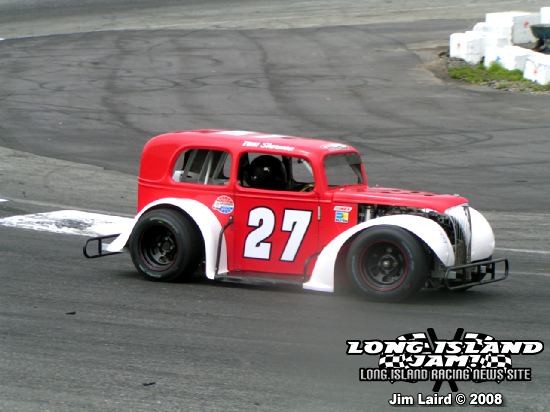 Would
the veterans have an insurmountable advantage over the rookies?
That was a debatable point. Right from the outset, it was
obvious that quite a few of the rookies would undoubtedly be
forces to reckon with, as many of them got up to speed with the
veterans fairly quickly. As veteran Tom Sherman noted, "My
experience at Riverhead was an advantage, but probably not as
much as you would think. It had been seven years since racing at
Riverhead in the Legends and a lot has changed in the division
in that time. My biggest advantage was knowing the cars
themselves." Paul Dodorico noted, "Before the season, I was
pretty confident that the experience of running Riverhead
previously would be a big help. Of course it was against some of
the new drivers, but there were some new drivers who caught on
very fast and surprised me how good they were. Four who come to
mind are Kevin Nowak, John Beatty, Tim Solomito, and Greg
DiCanio. They learned really quickly how to get a Legends car
around that quarter-mile."
Would
the veterans have an insurmountable advantage over the rookies?
That was a debatable point. Right from the outset, it was
obvious that quite a few of the rookies would undoubtedly be
forces to reckon with, as many of them got up to speed with the
veterans fairly quickly. As veteran Tom Sherman noted, "My
experience at Riverhead was an advantage, but probably not as
much as you would think. It had been seven years since racing at
Riverhead in the Legends and a lot has changed in the division
in that time. My biggest advantage was knowing the cars
themselves." Paul Dodorico noted, "Before the season, I was
pretty confident that the experience of running Riverhead
previously would be a big help. Of course it was against some of
the new drivers, but there were some new drivers who caught on
very fast and surprised me how good they were. Four who come to
mind are Kevin Nowak, John Beatty, Tim Solomito, and Greg
DiCanio. They learned really quickly how to get a Legends car
around that quarter-mile."
 Timmy
Solomito credited some of his success in the Legends car to his
experience in go-karts. "I believe driving go-karts gives you
all the fundamentals to driving a stock car," he noted, "and
also gives you basic abilities to improve upon in a stock car."
While competing as a rookie in the Legends division, Solomito
was also competing as a rookie in Riverhead’s Charger division,
in a full-fendered stock car. Solomito grabbed two wins in that
division while also racing the Legends car.
Timmy
Solomito credited some of his success in the Legends car to his
experience in go-karts. "I believe driving go-karts gives you
all the fundamentals to driving a stock car," he noted, "and
also gives you basic abilities to improve upon in a stock car."
While competing as a rookie in the Legends division, Solomito
was also competing as a rookie in Riverhead’s Charger division,
in a full-fendered stock car. Solomito grabbed two wins in that
division while also racing the Legends car.
Greg DiCanio also attributed some of his accomplishments in
the Legends car to his prior experience, and his most recent
experience had come in a 4/6 cylinder enduro pick-up truck. "I
don’t think I would have done it (Legends racing) if it wasn’t
here at Riverhead. I was going to sell the enduro truck anyway,
and I heard that they were going to run the Legends, so I went
out and bought one,” DiCanio noted. “I didn’t really think the
car was going to be anything until after I bought it and
everybody told me how powerful it was and how small it was and
it just seemed like it kept shrinking in my garage. Every time I
looked at it, I started thinking, ‘What did I do?’” DiCanio then
went to a racing school that essentially was the equivalent of
renting the track with a group of drivers, who were eventually
paired together based on lap times. Once DiCanio hit the track
at Riverhead, he felt that his enduro experience gave him an
advantage because, as he stated, “My truck was always loose. I
think that made it easier for me to get used to the feel of the
Legends car.”
Prior to the season, it had been decided that lineups would
be done through a draw system, where each driver drew a number
upon arriving at the raceway that determined their starting
position in their heat race. Feature race lineups were posted
based on the finishing order of the heats. Rookies started in
the rear of the field for three weeks, giving them the
opportunity to get some valuable seat time with the least risk
of jeopardizing everyone's equipment as they accustomed
themselves to the new vehicles. For the opening race, Silas
Hiscock Jr. started on the pole, and he went on to win the race.
By the luck of the draw and his heat race finish, Hiscock Jr.
was again on the pole for the second feature. He again claimed
the victory. At that time, it was agreed by all in the division
that feature winners would no longer start in the first two
rows. For 2009, the division will go to a regular handicapping
system.
The process of determining lineups was just one issue facing
the drivers in their transition back. Several drivers took time
to meet with officials from the raceway to discuss such things
as safety issues, differences in Legends cars that made
different on-track clean-up procedures necessary, and the
development of a system of communications between the drivers
and track personnel. Not all of the issues were ironed out on
the first attempt, but the drivers continued to come to the
track in healthy numbers, and input was offered that has made
continued improvements possible, with more expected for 2009.
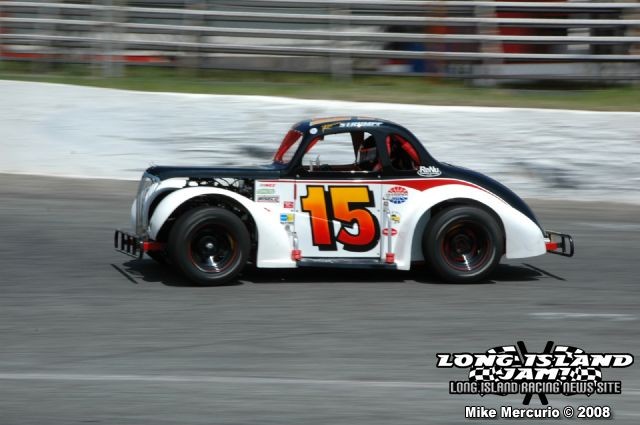 Following
Hiscock Jr.'s back-to-back wins, Connecticut's Michael Gervais
Jr. won the third race. Solomito started on the pole for the
fourth race and was able to hold off the rest of the field to
collect his first win. During the month of June, Hiscock Jr.
collected his third win and Solomito registered an impressive
second win in what was billed as one of the most exciting races
of the season in any division. Rookie John Beatty dominated the
month of August, collecting wins in both races. The season's
final race featured clean but tight side-by-side racing for the
lead, first between Dodorico and Connecticut's Max Zachem, and
later between Dodorico and Beatty.
Following
Hiscock Jr.'s back-to-back wins, Connecticut's Michael Gervais
Jr. won the third race. Solomito started on the pole for the
fourth race and was able to hold off the rest of the field to
collect his first win. During the month of June, Hiscock Jr.
collected his third win and Solomito registered an impressive
second win in what was billed as one of the most exciting races
of the season in any division. Rookie John Beatty dominated the
month of August, collecting wins in both races. The season's
final race featured clean but tight side-by-side racing for the
lead, first between Dodorico and Connecticut's Max Zachem, and
later between Dodorico and Beatty.
The season-long points battle was an interesting one. Hiscock
Jr. led for the first two weeks by virtue of his two feature
wins, but Sherman grabbed the lead after the third race. Sherman
began to pad his lead, as he had recorded three consecutive
second place finishes going into the last race of June. Sherman
had a bad race, getting caught up in on-track incidents while
Solomito drove to victory and into the points lead. Once out
front, Solomito did not look back. Solomito went into the last
race needing to finish 12th or better to secure the
championship. Showing the skill and patience of a veteran,
Solomito collected a seventh-place finish, walking away with the
division title. Overall, the top five in season points included
two veterans, Hiscock Jr. and Sherman; and three rookies,
Solomito, Beatty and DiCanio.
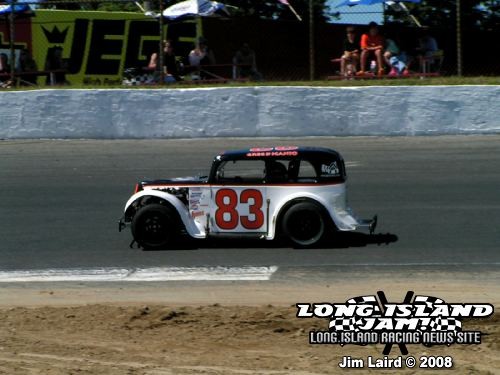 So,
how did their seasons compare to the expectations? Sherman’s
goals “were the same as they have been for every other year I
have raced, to be consistent. In the back of my mind I thought I
could win two or three races, but I didn’t obsess about it. My
season was successful for the first half, but the second half
left a lot to be desired.” Dodorico stated, “My goals were to
run up front and be consistent. Towards the end of the season, I
thought my racing improved to where I thought it should be. It
was a success for me personally because I had fun racing and we
will be doing it again in 2009.” Going into the season,
DiCanio’s goals were “to run up front and finish in the top ten.
I didn’t think I was going to go out there a win a bunch of
races, but I wanted to be competitive. I finished fifth in
points for the season, so I’d have to say the season was a
success for me personally.” Solomito went into the season
looking to “achieve rookie of the year, and to win as many races
as I could. I finished every race, which allowed me to get good
seat time. I didn’t finish out of the top ten. I won two races
and the championship. I felt it was very successful.”
So,
how did their seasons compare to the expectations? Sherman’s
goals “were the same as they have been for every other year I
have raced, to be consistent. In the back of my mind I thought I
could win two or three races, but I didn’t obsess about it. My
season was successful for the first half, but the second half
left a lot to be desired.” Dodorico stated, “My goals were to
run up front and be consistent. Towards the end of the season, I
thought my racing improved to where I thought it should be. It
was a success for me personally because I had fun racing and we
will be doing it again in 2009.” Going into the season,
DiCanio’s goals were “to run up front and finish in the top ten.
I didn’t think I was going to go out there a win a bunch of
races, but I wanted to be competitive. I finished fifth in
points for the season, so I’d have to say the season was a
success for me personally.” Solomito went into the season
looking to “achieve rookie of the year, and to win as many races
as I could. I finished every race, which allowed me to get good
seat time. I didn’t finish out of the top ten. I won two races
and the championship. I felt it was very successful.”
Most importantly for the Legends, however, was not the
success of any individual driver, but the success of the
division’s return overall. Each race drew more than 20
competitors – in fact, they averaged 21.5 cars per event.
Solomito stated, “I felt that it was a successful season for the
Legends cars, with a high car count and good side-by-side
racing.” Sherman echoed the sentiment. “For the division, I
believe it really was a success. It was a good, if not great,
start. It was enough to get everyone’s feet wet but at the same
time, not lose people from running out of time and money. We
kept showing up with cars.” DiCanio pointed out, “It was
successful for us as a division, but it’s really just the
beginning. With so many kids who can step up from go-karts into
Legends cars, I think we really showed them a good outlet to
take the next step, and that should make the division keep
growing as long as we continue to race at Riverhead.” Dodorico
summarized the season by saying, “We were able to show the track
owners and the fans what we can do with Legends cars. The fans
were always receptive to our cars. We had a champion who is a
very talented 16-year-old driver who before this season had
never set foot in a Legends car. I think that was a very
positive event for our division.”
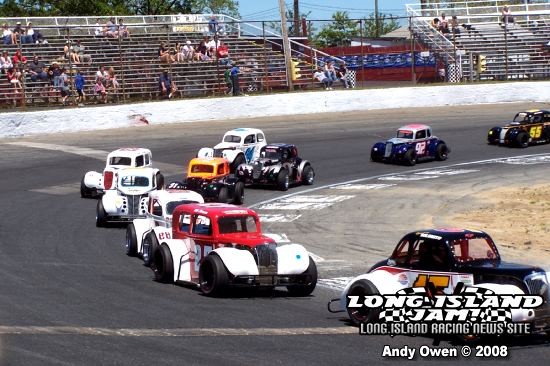 Based
on the success of the 2008 season, Riverhead Raceway owners and
promoters Barbara and Jim Cromarty have increased the number of
scheduled shows to 12 for the coming year. With that, the
drivers, family and friends, and fans alike all look forward to
2009, expected to be a season of building on the positives that
were revealed in the Legends division’s return.
Based
on the success of the 2008 season, Riverhead Raceway owners and
promoters Barbara and Jim Cromarty have increased the number of
scheduled shows to 12 for the coming year. With that, the
drivers, family and friends, and fans alike all look forward to
2009, expected to be a season of building on the positives that
were revealed in the Legends division’s return.
Source: Reprinted
from 600 Racing Magazine
Posted:
February 5, 2009